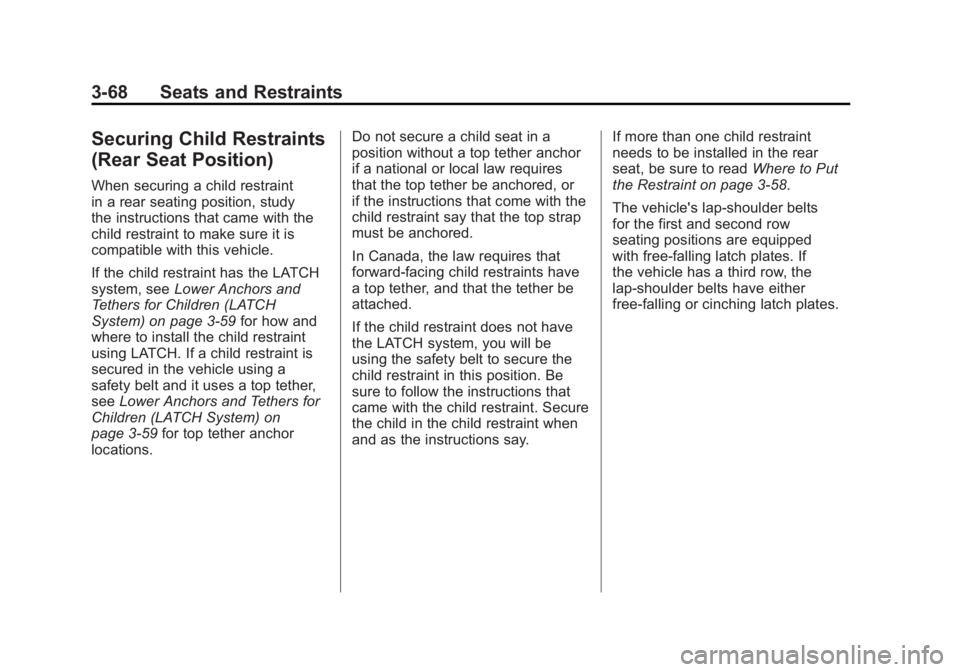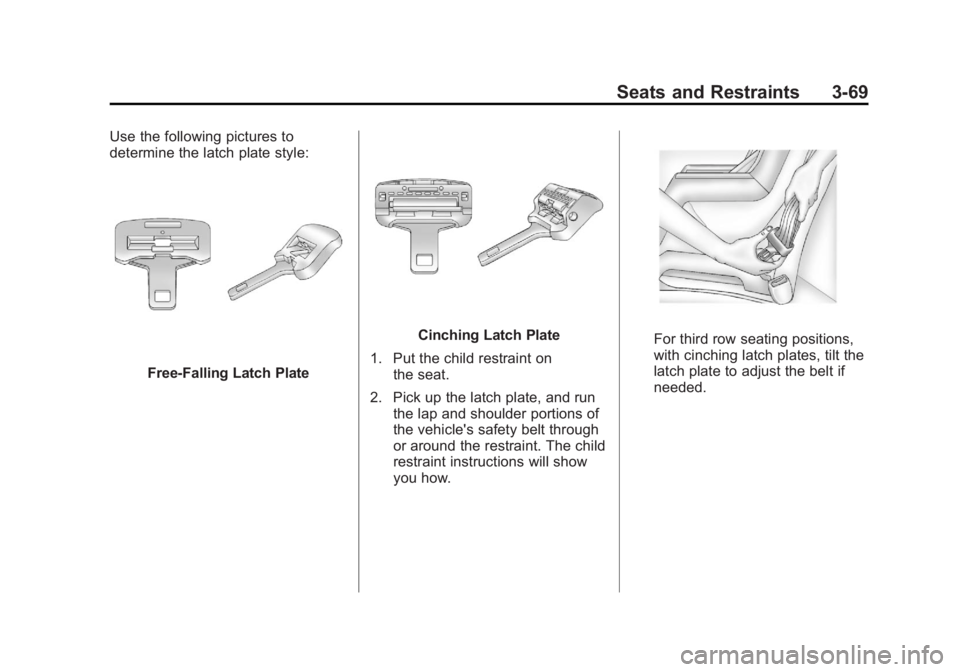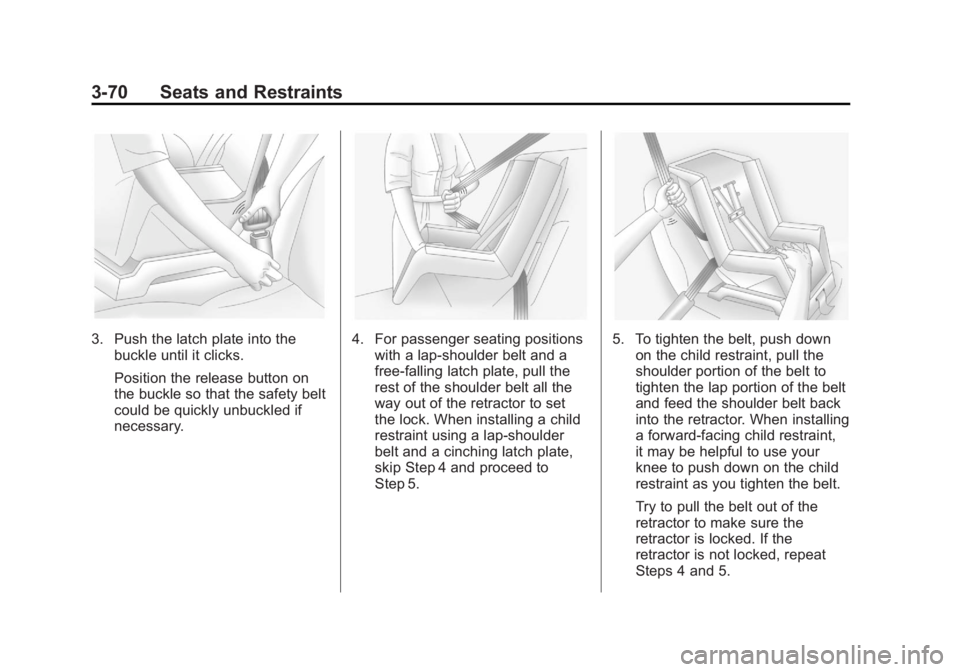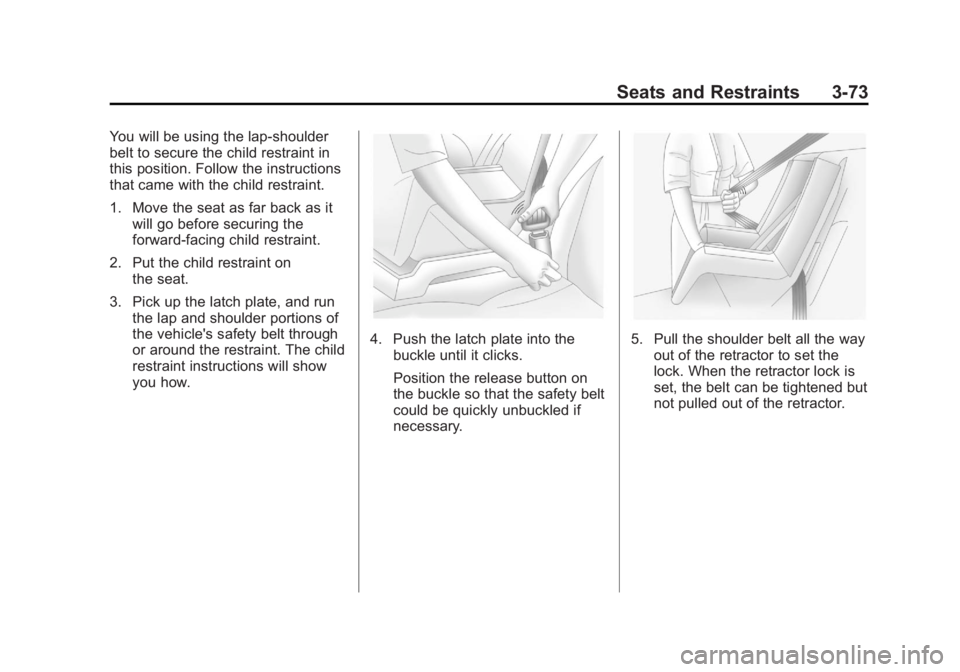2011 CADILLAC ESCALADE ESV seats
[x] Cancel search: seatsPage 124 of 548

Black plate (68,1)Cadillac Escalade/Escalade ESV Owner Manual - 2011
3-68 Seats and Restraints
Securing Child Restraints
(Rear Seat Position) When securing a child restraint
in a rear seating position, study
the instructions that came with the
child restraint to make sure it is
compatible with this vehicle.
If the child restraint has the LATCH
system, see Lower Anchors and
Tethers for Children (LATCH
System) on page 3 ‑ 59 for how and
where to install the child restraint
using LATCH. If a child restraint is
secured in the vehicle using a
safety belt and it uses a top tether,
see Lower Anchors and Tethers for
Children (LATCH System) on
page 3 ‑ 59 for top tether anchor
locations. Do not secure a child seat in a
position without a top tether anchor
if a national or local law requires
that the top tether be anchored, or
if the instructions that come with the
child restraint say that the top strap
must be anchored.
In Canada, the law requires that
forward-facing child restraints have
a top tether, and that the tether be
attached.
If the child restraint does not have
the LATCH system, you will be
using the safety belt to secure the
child restraint in this position. Be
sure to follow the instructions that
came with the child restraint. Secure
the child in the child restraint when
and as the instructions say. If more than one child restraint
needs to be installed in the rear
seat, be sure to read Where to Put
the Restraint on page 3 ‑ 58 .
The vehicle's lap ‐ shoulder belts
for the first and second row
seating positions are equipped
with free ‐ falling latch plates. If
the vehicle has a third row, the
lap ‐ shoulder belts have either
free ‐ falling or cinching latch plates.
Page 125 of 548

Black plate (69,1)Cadillac Escalade/Escalade ESV Owner Manual - 2011
Seats and Restraints 3-69Use the following pictures to
determine the latch plate style:
Free ‐ Falling Latch Plate Cinching Latch Plate
1. Put the child restraint on
the seat.
2. Pick up the latch plate, and run
the lap and shoulder portions of
the vehicle's safety belt through
or around the restraint. The child
restraint instructions will show
you how. For third row seating positions,
with cinching latch plates, tilt the
latch plate to adjust the belt if
needed.
Page 126 of 548

Black plate (70,1)Cadillac Escalade/Escalade ESV Owner Manual - 2011
3-70 Seats and Restraints
3. Push the latch plate into the
buckle until it clicks.
Position the release button on
the buckle so that the safety belt
could be quickly unbuckled if
necessary. 4. For passenger seating positions
with a lap ‐ shoulder belt and a
free ‐ falling latch plate, pull the
rest of the shoulder belt all the
way out of the retractor to set
the lock. When installing a child
restraint using a lap ‐ shoulder
belt and a cinching latch plate,
skip Step 4 and proceed to
Step 5. 5. To tighten the belt, push down
on the child restraint, pull the
shoulder portion of the belt to
tighten the lap portion of the belt
and feed the shoulder belt back
into the retractor. When installing
a forward-facing child restraint,
it may be helpful to use your
knee to push down on the child
restraint as you tighten the belt.
Try to pull the belt out of the
retractor to make sure the
retractor is locked. If the
retractor is not locked, repeat
Steps 4 and 5.
Page 127 of 548

Black plate (71,1)Cadillac Escalade/Escalade ESV Owner Manual - 2011
Seats and Restraints 3-716. If the child restraint has a top
tether, follow the child restraint
manufacturer's instructions
regarding the use of the top
tether. See Lower Anchors and
Tethers for Children (LATCH
System) on page 3 ‑ 59 for more
information.
7. Before placing a child in the
child restraint, make sure it is
securely held in place. To check,
grasp the child restraint at the
safety belt path and attempt
to move it side ‐ to ‐ side and
back ‐ and ‐ forth. When the child
restraint is properly installed,
there should be no more than
2.5 cm (1 in) of movement.
To remove the child restraint,
unbuckle the vehicle safety belt and
let it return to the stowed position.
If the top tether is attached to a top
tether anchor, disconnect it. Securing Child Restraints
(Center Front Seat
Position)
{ WARNINGA child in a child restraint in the
center front seat can be badly
injured or killed by the frontal
airbags if they inflate. Never
secure a child restraint in the
center front seat. It is always
better to secure a child restraint
in a rear seat.
Do not use child restraints in the
center front seat position. Securing Child Restraints
(Right Front Seat
Position) This vehicle has airbags. A rear
seat is a safer place to secure a
forward-facing child restraint. See
Where to Put the Restraint on
page 3 ‑ 58 .
In addition, the vehicle may have a
passenger sensing system which is
designed to turn off the right front
passenger frontal airbag under
certain conditions. See Passenger
Sensing System on page 3 ‑ 44 and
Passenger Airbag Status Indicator
on page 5 ‑ 16 for more information,
including important safety
information.
Page 128 of 548

Black plate (72,1)Cadillac Escalade/Escalade ESV Owner Manual - 2011
3-72 Seats and Restraints A label on the sun visor says,
“ Never put a rear-facing child seat
in the front. ” This is because the risk
to the rear-facing child is so great if
the airbag deploys.
{ WARNINGA child in a rear-facing child
restraint can be seriously
injured or killed if the right front
passenger airbag inflates. This
is because the back of the
rear-facing child restraint would
be very close to the inflating
airbag. A child in a forward-facing
child restraint can be seriously
injured or killed if the right front
passenger airbag inflates and the
passenger seat is in a forward
position.
The vehicle may have a
passenger sensing system
which is designed to turn off the
right front passenger frontal
airbag under certain conditions.
(Continued) WARNING (Continued) Even if the passenger sensing
system, if equipped, has turned
off the right front passenger
frontal airbag, no system is
fail-safe. No one can guarantee
that an airbag will not deploy
under some unusual
circumstance, even though
it is turned off.
Secure rear-facing child
restraints in a rear seat, even if
the airbag is off. If you secure a
forward-facing child restraint in
the right front seat, always move
the front passenger seat as far
back as it will go. It is better to
secure the child restraint in a
rear seat.
See Passenger Sensing System
on page 3 ‑ 44 for additional
information. If the child restraint has the LATCH
system, see Lower Anchors and
Tethers for Children (LATCH
System) on page 3 ‑ 59 for how and
where to install the child restraint
using LATCH. If a child restraint is
secured using a safety belt and it
uses a top tether, see Lower
Anchors and Tethers for Children
(LATCH System) on page 3 ‑ 59 for
top tether anchor locations.
Do not secure a child seat in a
position without a top tether anchor
if a national or local law requires
that the top tether be anchored, or if
the instructions that come with the
child restraint say that the top strap
must be anchored.
In Canada, the law requires that
forward-facing child restraints have
a top tether, and that the tether be
attached.
Page 129 of 548

Black plate (73,1)Cadillac Escalade/Escalade ESV Owner Manual - 2011
Seats and Restraints 3-73You will be using the lap-shoulder
belt to secure the child restraint in
this position. Follow the instructions
that came with the child restraint.
1. Move the seat as far back as it
will go before securing the
forward-facing child restraint.
2. Put the child restraint on
the seat.
3. Pick up the latch plate, and run
the lap and shoulder portions of
the vehicle's safety belt through
or around the restraint. The child
restraint instructions will show
you how. 4. Push the latch plate into the
buckle until it clicks.
Position the release button on
the buckle so that the safety belt
could be quickly unbuckled if
necessary. 5. Pull the shoulder belt all the way
out of the retractor to set the
lock. When the retractor lock is
set, the belt can be tightened but
not pulled out of the retractor.
Page 130 of 548

Black plate (74,1)Cadillac Escalade/Escalade ESV Owner Manual - 2011
3-74 Seats and Restraints
6. To tighten the belt, push down
on the child restraint, pull the
shoulder portion of the belt to
tighten the lap portion of the belt,
and feed the shoulder belt back
into the retractor. When installing
a forward-facing child restraint,
it may be helpful to use your
knee to push down on the child
restraint as you tighten the belt. Try to pull the belt out of the
retractor to make sure the
retractor is locked. If the
retractor is not locked, repeat
Steps 5 and 6.
7. Before placing a child in the
child restraint, make sure it is
securely held in place. To check,
grasp the child restraint at the
safety belt path and attempt
to move it side ‐ to ‐ side and
back ‐ and ‐ forth. When the child
restraint is properly installed,
there should be no more than
2.5 cm (1 in) of movement. If the vehicle is equipped with the
passenger sensing system, and
when the passenger sensing
system has turned off the right front
passenger frontal airbag, the off
indicator in the passenger airbag
status indicator should light and stay
lit when you start the vehicle. See
Passenger Airbag Status Indicator
on page 5 ‑ 16 .
If a child restraint has been
installed and the on indicator is lit,
see “ If the On Indicator is Lit for a
Child Restraint ” under Passenger
Sensing System on page 3 ‑ 44 for
more information.
To remove the child restraint,
unbuckle the vehicle safety belt and
let it return to the stowed position.
Page 133 of 548

Black plate (3,1)Cadillac Escalade/Escalade ESV Owner Manual - 2011
Storage 4-3
Center Console Storage A console compartment is located
between the bucket seats.
The console has both an upper and
lower storage bin accessed by lifting
up on the latches located at the
front of the console lid.
The console may have an
accessory power outlet inside.
See Power Outlets on page 5 ‑ 9 .
The rear of the console also has a
cupholder that swings down for the
rear seat passengers to use. Roof Rack System
{ WARNINGIf something is carried on top of
the vehicle that is longer or wider
than the roof rack — like paneling,
plywood, or a mattress — the
wind can catch it while the vehicle
is being driven. The item being
carried could be violently torn off,
and this could cause a collision
and damage the vehicle. Never
carry something longer or wider
than the roof rack on top of the
vehicle unless using a GM
certified accessory carrier.
For vehicles with a roof rack, the
rack can be used to load items.
For roof racks that do not have
crossrails included, GM Certified
crossrails can be purchased as an
accessory. See your dealer for
additional information. For vehicles with crossrails, they
can be moved back and forth to
help secure cargo. To adjust them,
turn the knob located at each end of
the crossrail counterclockwise until
the crossrail can move freely. To
secure the crossrail, turn the knob
located at each end of the crossrail
clockwise until tightened. Tie the
load to the siderails or siderail
supports.
Notice: Loading cargo on the
roof rack that weighs more than
91 kg (200 lbs) or hangs over the
rear or sides of the vehicle may
damage the vehicle. Load cargo
so that it rests evenly between
the crossrails, making sure to
fasten cargo securely.
To prevent damage or loss of cargo
when driving, check to make sure
crossrails and cargo are securely
fastened. Loading cargo on the roof
rack will make the vehicle ’ s center
of gravity higher. Avoid high speeds,